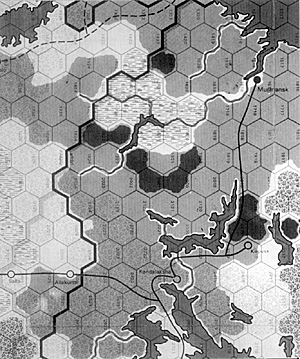
South of the "A" weather line the Finnish cavalry and a ski brigade should be used along with motorized German 1-10 type units to drive from the "A" weather line south to about the 4300 hex row. A single Axis unit will take the Russian at least two or three units to contain and keeping the c/ m battalions away from the rail line while standing up to the brigades may prove impossible. At any rate the troops the Russian will have to commit here is out of proportion to the physical threat the intruders represent: the Murmansk rail line must stay open if the German is prosecuting an offensive in the Arctic and the Russians intend to stop him.
The full five German RE limit should be used to support the Finns. No matter what is happening on the main front the Russian won't be able to commit his tank divisions there unless he's willing to risk losing them. Finland is another matter entirely! A crafty Russian will let the Finns move toward Petrozavoclsk (as good Finns should) and then hit the Viipuri sector hard with strong air and naval support and the tank armies he is unwilling to commit on the main front.
With this in mind, the best German units for Finland are 1-10 mot hv AA battalions because of their full ATEC and 2 points of AA. Station Finnish fighters, not German ones, at Viipuri. One Ju88A stationed at Joensuu is relatively cost effective and can also be used to hit the Murmansk rail line or support attacks in the Arctic.
Preponderance of power isn't necessary for the Finnish drive on the Murmansk rail line - multiple threats are more effective as they force the Russian to commit troops a turn ahead of time *in several areas because of th e remoteness of the terrain. Be sure to screen the northern shore of Lake Ladoga against amphibious landings behind your main line. If the Soviets land properly they can put ZOCs behind your flank divisions anchored on the shore of the lake and cut retreats.
Driving toward Leningrad is dangerous and ineffective, stopping at Viipuri is sufficient provided the Finns regain control of the rail line out of Leningrad each turn. The Russian can put a lot of pressure on Viipuri and the Finns must maintain a strong covering force from Viipuri to Lake Ladoga to keep the drive on Petrozavoclsk from being stalled. The Finns can be hit pretty hard by the Soviet navy attacking from the safe zone, especially if used in combination with tank forces.
The woods and rivers, coupled with the 0-8 hv AA and German 1-10 mot hv AA battalions (and, if at all possible, forts) should reduce the effectiveness of any Russian tanks pouring out of Leningrad. Maintain control of the rail hexes out of Leningrad by putting a ZOC on them or dashing two of the 1-10 mot hv AA battalions over the hexes, returning to the line during exploit.
Since Leningrad usually has a lot of construction assets, the Russian can probably repair every rail in sight, but unless he also owns the hexes at the start of the phase they can't be used for rail movement that turn. This hampers the Soviets from making a surprise sweep north out of Leningrad.
To conclude, all these drives on the Murmansk railroad, combined with the casualties sure to be caused, will guarantee that the Soviets don't get a free ride in the Arctic.
German Play in 1941 Part One Hints on Playing Fire in the East
- Introduction
Panzers and Breakthroughs
Complicating the Red Retreat
The Northern Campaign
The Finnish Theater
German Play in 1941 Part Two Army Group North and the Leningrad Campaign
Germany Play in 1941 Part Three The Final Chapter
Back to Europa Number 14 Table of Contents
Back to Europa List of Issues
Back to MagWeb Master Magazine List
© Copyright 1990 by GR/D
This article appears in MagWeb (Magazine Web) on the Internet World Wide Web. Other military history articles and gaming articles are available at http://www.magweb.com